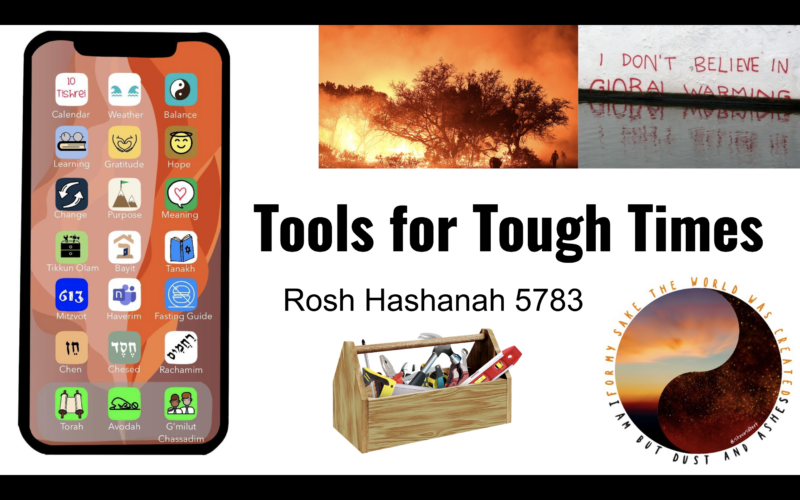
Last month, the Academy of American Poets shared a Poem of the Day by Joshua Jennifer Espinoza called “The Sunset and the Purple-Flowered Tree.” Here’s how it begins:
I talk to a screen who assures me everything is fine.
I am not broken. I am not depressed. I am simply
in touch with the material conditions of my life. It is
the end of the world, and it’s fine…
The poem reminded me of so many of our conversations over the last year. We are not broken. We are simply in touch with the material conditions of our lives.
Long Covid continues to mystify doctors. Apparently polio is back. Election denial corrodes our civic life. There are heartbreaking stories out of states where reproductive health care is now banned. And don’t forget school shootings, 29 of them so far this year. And Putin trying to take over Ukraine. And this year has brought a rise in laws designed to abridge the rights of LGBTQIA+ folks, and antisemitism, too.
And then there’s the climate crisis. Floods like the one in Kentucky – or in Pakistan, or in Chad. Wildfires (when I wrote this, there were 624 wildfires burning in eighteen states, plus many more around the world.) Extreme heat melting airport runways…
As my friend Rabbi Mike Moskowitz sometimes says, “the world is super broken.” I know that many of us are struggling. Some are languishing, living with “a sense of stagnation and emptiness.” (per Adam Grant in the New York Times.) And for some of us, languishing can slip into hopelessness.
Our liturgy proclaims: hayom harat olam: today the world is born!
Okay, but how do we celebrate the world’s birthday when things feel so hard?
This is not the first time the Jewish community has lived through collective crisis. The question I’ve been asking is: what spiritual tools did our forebears use to get through hard times? What did Judaism’s toolbox offer them, and what can it offer us?
When Rome destroyed the second Temple, R. Yochanan ben Zakkai asked two of his disciples to smuggle him out of Jerusalem in a coffin. He went to the Roman general Vespasian and asked for permission to build a school in Yavneh. The learning there preserved oral teachings about how we “did Jewish” in Temple times. Those became the Mishna, the kernel at the heart of Talmud. In the ashes of the Temple, the sprouts of rabbinic Judaism took root.
Our response to complete destruction was to remember and to learn – and in the learning, to begin to design Judaism anew. That’s the first spiritual technology I think of when I think of how Jews have lived through crisis times before. What they did — remembering what was lost and rethinking what came next — can help us too. It can lift us out of ourselves, and it can inspire us to build. And maybe those who came before faced something like this, and we can learn from their response.
Or maybe their response feels off-key to us, and we can learn from that, too. Either way, notice their balance between remembering what was, and imagining what might yet be. We don’t want a Judaism that drives only with the rearview mirror – and we also don’t want a Judaism that ignores the wisdom of our ancestors. Holding what was and what will be in balance: that’s Tiferet, this year’s theme for the Days of Awe. (More on that in a moment.)
For spiritual nourishment, my go-to place is the Hasidic masters – the rabbis from the 1700s and 1800s who sought spirituality in everything. For others, it might be mussar, texts of ethical self-improvement.
Maybe the learning that nourishes us is secular. I’m trying to learn from my foremothers who marched and agitated for a woman’s right to choose – while also learning from Black voices, trans voices, and people of color about how the framework of reproductive justice is more inclusive. I learn about our nation’s history and its present every day from historian Heather Cox Richardson’s Letters From an American, which help me contextualize current events.
And I’m learning about how to face the climate crisis…from scientists who teach that our inner lives have an impact on how we approach our outer lives.
[T]here are bats
Who catch fish
And slime molds that singAnd ancient Greenland sharks
Who don’t even reach sexual maturity
Until they are 150 years old.This is what I want to say
To those who believe
The Earth is already doomed:Just look at the capacity
Of this
Gloriously complex planet.
That poem appears at the beginning of Dr. Elin Kelsey’s Hope Matters: Why Changing the Way We Think is Critical to Solving the Environmental Crisis, and it’s a bridge to another spiritual technology I think is core: hope. Historically Jews have hoped ardently for redemption, the coming of the messiah or (in Reform language) the messianic age. Those ideas may feel foreign to us, but the need for hope persists.
So how do we cultivate hope in the face of climate crisis and all the rest?
“To hope is not to wait around until you are feeling optimistic,” Kelsey writes,”but to join with others in defiant response to what we are doing to the planet. It is an action that you do rather than a feeling that you have.”
As Seamus Heaney wrote, “Hope is not optimism, which expects things to turn out well, but something rooted in the conviction that there is good worth working for.” There is good worth working for. Even amidst everything – or especially amidst everything. Working toward something better can lift us up. Sometimes we call that tikkun olam – repairing the broken world.
We find hope through action, and we take action to help others. None of us can balm all of the world’s hurts – but there’s always something we can do for someone somewhere. In order to move beyond despair, we need balance, perspective – in a word, Tiferet.
As we said in last night’s d’var, Tiferet is the sacred and: the balance of love and power, head and heart, recognizing that the world is a dumpster fire and that today the world begins anew. It’s the “and” of real balance that powers us to change, and to heal the world.
For many of us, focusing locally is a good use of energy. ‘Maybe “rewild” some of your lawn as we’ve done here, creating more habitat for pollinators and restoring local ecosystems. Or give money or time to Jewish Family Service helping new immigrant families make their homes in the Berkshires.
And if you want to look at a bigger picture, remember that the world’s injustices tend to most impact those who were already most vulnerable, and look for organizations on the ground already doing the work. The Red Cross is helping flood victims in Kentucky. Fair Fight is working to stop voter suppression. The National Council of Jewish Women is helping people access reproductive healthcare.
There are so many ways to contribute to the work of repair. Civic engagement can be an act of repair. Voting. Activism. Tzedakah – e.g. giving motivated by justice. You’ll know best what you feel able to do. Listen inside for what tugs at your heart.
I don’t want to minimize. Climate grief is real. The erosion of rights is real, and so are antisemitism, gun violence and more. In the words of the Espinoza poem, these are the “material conditions of …life.” We are all exposed to horrifying events happening around the world daily – like the laundry list with which this sermon began. We need to lift each other out of the miasma of grief and languishing.
That’s another of Judaism’s tools for tough times: lifting each other up. Talmud teaches (Brachot 5b) that a prisoner can’t release themself from jail, and a sick person can’t lift their own spirits on their sickbed. When I was hospitalized over the summer, I learned again how right Talmud is about that!
But it’s not just about that. There are so many ways to live this teaching. Giving words of hope to uplift someone who’s feeling hopeless. Helping someone out of an abusive relationship or out of poverty. Helping someone with addiction or depression or an eating disorder. Bearing witness and speaking truth. The work of allyship – using our privilege to stand up for others, working against systemic oppressions like racism, sexism, homophobia, transphobia.
Lifting each other up requires Tiferet, balance. (This is a literal truth, and also a spiritual one.) It also gives us balance, because it means we’re not in this alone.
“Acceptance of what is,” writes Dr. Kelsey, “is not the same as fatalism about what comes next.” Authentic spiritual life asks us to face reality – we don’t get to ignore what’s broken. But we don’t stop there. Opening our eyes to what is is the first step toward what will be. That’s another form of balance: holding what is beside what will be.
At the burning bush God says, “I will be what I will be” – or “I am becoming what I am becoming.” Jews find God in change. (If the “G-word” doesn’t work for you, try “meaning” — more about that in a moment.)
Judaism is not new to change. Our world has collapsed before. And not just ours! When Europeans came to these shores, our arrival shattered the conceptual and practical world inhabited by Native Americans and First Nations people. Author Rebecca Roanhorse, of Ohkay Owingeh Pueblo descent, told the Times, “We’ve already survived an apocalypse.” Despite anti-Indian laws and boarding schools designed to strip them of their heritage, Native Americans and First Nations peoples are still here.
And the same is true of the Jewish people. (And of course it is possible to be both Native and Jewish, an inheritor of both of these wisdom traditions.) There’s a lot of apocalyptic talk out there, but I choose to believe that humanity and Judaism will both survive. This isn’t the end. So what will future generations need us to have done? And what will Judaism need to become? Our tradition invites us to find meaning in change, and on the other side of change, too.
Our tradition invites us to find meaning in… pretty much everything. We find meaning, story, and ethical teaching in every part of Torah – even in repeated words or the crowns atop the letters! The meaning we find may change as we do, but the fact of finding meaning is constant. That’s another one of our spiritual technologies: finding meaning, or making meaning, no matter what.
As Jews we wrest meaning from our deep library of texts and traditions, and we also search for meaning in the lived Torah of human experience.
Searching for meaning, Victor Frankl wrote, is what sustained him during the Holocaust. And not only him: in the concentration camps, those who searched for meaning had a greater chance of survival. In his words:
Woe to him who saw no more sense in his life, no aim, no purpose, and therefore no point in carrying on. He was soon lost… . What was really needed was a fundamental change in our attitude toward life. We had to learn … that it did not really matter what we expected from life, but rather what life expected from us.
We find meaning by asking what life expects from us. What will the future need us to have done? What does Judaism need to become? What can we repair? What can we learn? What actions will help us hope?
Illustration by Steve Silbert.
Rabbi Simcha Bunim carried two slips of paper in his pockets. One read, “For my sake was the world created,” and the other, “I am dust and ashes.” When he felt low, he’d look at the teaching from Talmud that says the whole world was made just for us. And when he felt high and mighty, he’d look at Torah’s reminder that everything will die. Our task is holding those two truths in balance – holding the whole within which both of these truths reside.
(And to help you in so doing, the card on your chair is for you to take home and carry with you — courtesy of Steve Silbert and Bayit.)
That story is one of my touchstones… and to me it exemplifies Tiferet. Tiferet is the whole within which Simcha Bunim’s two truths coexist. Tiferet is balance that lifts us up: not ignoring what’s hard, and also not getting stuck in it. Tiferet invites us to recognize the brokenness and work toward wholeness. Tiferet invites us to see both the world and ourselves with clear eyes: the mistakes we’ve made, and the transformations we could achieve. That we are dust, and that creation was made for us.
In the words of Rabbi Lord Jonathan Sacks z”l, “[t]o be a Jew is to be an agent of hope in a world serially threatened by despair.” If you are languishing or feeling despair – climate despair, political despair, personal despair – you are not alone. Come and find me, and I’ll help you connect with sources of help. Suffering does not earn us spiritual merit points. As our Buddhist friends say: pain is inevitable, but suffering is not.
Come and find me, and I’ll sit on the ground with you in mourning, because I’m there too sometimes. And then together we’ll balance anxiety with agency, and help each other rise. Because to be a Jew is to be an agent of hope, and we reach hope through actions of repair.
In the Passover story, God hears our cry and lifts us out of there with a mighty hand and an outstretched arm. We may struggle with that story these days. If God can lift us out, why is our world like this? But Jewish tradition offers us not only that transcendent God, but also divine immanence. Divinity that goes into exile with us, weeps with us, feels with us. God is in our arms and fingers and voices, in every action we take that brings hope.
If you want a Jewish “app” for thriving during crisis times – what you’ve just heard are the ones I’ve got.
And weren’t these always our job? It’s on us to lift each other up, to make meaning, to retell and rebuild and repair. It’s on us to recalibrate and rebalance — to recognize the brokenness and work toward wholeness. It’s on us to remember that there is good worth working for. Especially in times like these.
May opening our eyes to what is be the first step toward what will be.
And may 5783 be a new year of tiferet:
balancing “I am dust and ashes” with “the world was created for me;”
balancing justice with mercy, clear eyes with full hearts, and grief with hope.
This is the sermon that Rabbi Rachel gave on the first morning of Rosh Hashanah. Offered here with extra gratitude to Steve Silbert for the phone illustration and the Finding Balance cards. Cross-posted to Velveteen Rabbi.





